An Exploration of Spatial and Social Inequalities of Urban Sports Facilities in Nanning City, China
Abstract
:1. Introduction
2. Literature Review
3. Materials and Methods
3.1. Study Area
3.2. Data Collection
3.3. Methods
3.3.1. Regional Allocation
3.3.2. Spatial Accessibility
3.3.3. Discrete Value, Coefficient of Variation and Diversity of Sports Facilities
3.3.4. GWR (Geographically Weighted Regression) Model
4. Results
4.1. Spatial Inequality of Sports Facilities
4.2. Disparate Accessibility to Sports Facilities
4.3. Diversity of Sports Facilities
4.4. Geographical Weighted Regression (GWR) Analysis
5. Conclusions
Author Contributions
Funding
Conflicts of Interest
References
- Swann, W.L.; Brixey, E.; Wohler, W. Linking local sustainability policies to health outcomes: An analysis of the urban sustainability-health nexus. J. Urban Aff. 2019, 41, 1–18. [Google Scholar] [CrossRef]
- Li, F.Z. Physical activity and health in the presence of China’s economic growth: Meeting the public health challenges of the aging population. J. Sport Health Sci. 2016, 5, 258–269. [Google Scholar] [CrossRef] [PubMed] [Green Version]
- Wu, S.; Luo, Y.; Qiu, X.; Bao, M. Building a healthy China by enhancing physical activity: Priorities, challenges, and strategies. J. Sport Health Sci. 2016, 6, 125–126. [Google Scholar] [CrossRef] [Green Version]
- Yang, J.; Siri, J.G.; Remais, J.V.; Cheng, Q.; Zhang, H.; Chan, K.K.Y.; Sun, Z.; Zhao, Y.; Cong, N.; Li, X.; et al. The Tsinghua–Lancet Commission on Healthy Cities in China: Unlocking the power of cities for a healthy China. Lancet 2018, 391, 2140–2184. [Google Scholar] [CrossRef] [Green Version]
- Zhang, C.; Gong, P. Healthy China: From words to actions. Lancet Public Health 2019, 4, e438–e439. [Google Scholar] [CrossRef] [Green Version]
- World Health Organization (WHO). Global Action Plan on Physical Activity 2018–2030: More Active People for a Healthier World; WHO: Geneva, Sweden, 2018. [Google Scholar]
- Shrestha, S.; Kestens, Y.; Thomas, F.; El Aarbaoui, T.; Chaix, B. Spatial access to sport facilities from the multiple places visited and sport practice: Assessing and correcting biases related to selective daily mobility. Soc. Sci. Med. 2019, 236, 112406. [Google Scholar] [CrossRef]
- Hoekman, R.; Breedveld, K.; Kraaykamp, G. A landscape of sport facilities in the Netherlands. Int. J. Sport Policy Politics 2015, 8, 305–320. [Google Scholar] [CrossRef]
- Zheng, J.; Chen, S.; Tan, T.-C.; Lau, P. Sport policy in China (Mainland). Int. J. Sport Policy Politics 2018, 10, 1–23. [Google Scholar] [CrossRef]
- Dadashpoor, H.; Rostami, F.; Alizadeh, B. Is inequality in the distribution of urban facilities inequitable? Exploring a method for identifying spatial inequity in an Iranian city. Cities 2016, 52, 159–172. [Google Scholar] [CrossRef]
- Zhang, L.; Zhou, T.; Mao, C. Does the Difference in Urban Public Facility Allocation Cause Spatial Inequality in Housing Prices? Evidence from Chongqing, China. Sustainability 2019, 11, 6096. [Google Scholar] [CrossRef] [Green Version]
- Jiang, H.Y.; Zhou, C.S.; Xiao, R.B. Spatial differentiation and social equity of public parks in Guangzhou. China City Plan. Rev. 2010, 34, 43–48. (In Chinese) [Google Scholar]
- Talen, E.; Anselin, L. Assessing Spatial Equity: An Evaluation of Measures of Accessibility to Public Playgrounds. Environ. Plan. A: Econ. Space 1998, 30, 595–613. [Google Scholar] [CrossRef] [Green Version]
- Yuan, Y.; Xu, J.; Wang, Z.-B. Spatial Equity Measure on Urban Ecological Space Layout Based on Accessibility of Socially Vulnerable Groups—A Case Study of Changting, China. Sustainability 2017, 9, 1552. [Google Scholar] [CrossRef] [Green Version]
- Rich, R.C. Neglected Issues in the Study of Urban Service Distributions: A Research Agenda. Urban Stud. 1979, 16, 143–156. [Google Scholar] [CrossRef]
- Harvey, D. Social Justice and the City; The University of Georgia Press: Georgia, GA, USA, 2009; pp. 22–49. [Google Scholar]
- Teitz, M.B. Toward a theory of urban public facility location. Pap. Reg. Sci. 1968, 21, 35–51. [Google Scholar] [CrossRef]
- Bigman, D.; Revelle, C. The Theory of Welfare Considerations in Public Facility Location Problems. Geogr. Anal. 2010, 10, 229–240. [Google Scholar] [CrossRef]
- Church, R.; Revelle, C. The maximal covering location problem. Pap. Reg. Sci. 1974, 32, 101–118. [Google Scholar] [CrossRef]
- Cooper, L. Location-Allocation Problems. Oper. Res. 1963, 11, 331–343. [Google Scholar] [CrossRef]
- Hakimi, S.L. Optimum Distribution of Switching Centers in a Communication Network and Some Related Graph Theoretic Problems. Oper. Res. 1965, 13, 462–475. [Google Scholar] [CrossRef]
- Cox, K.R.; Johnston, R.J. Conflict, Politics, and the Urban Scene; Martin’s Press: New York, NY, USA, 1982. [Google Scholar]
- Nelson, C.A.; Wolch, J.R. Intrametropolitan planning for community-based residential care: A goals programming approach. Socio-Economic Plan. Sci. 1985, 19, 205–212. [Google Scholar] [CrossRef]
- Pacione, M. Access to urban services—the case of secondary schools in Glasgow. Scott. Geogr. Mag. 1989, 105, 12–18. [Google Scholar] [CrossRef]
- Martin, D.; Williams, H.C.W.L. Market-area analysis and accessibility to primary health care centers. Environ. Plan. A 1992, 24, 1009–1019. [Google Scholar] [CrossRef]
- Scott, D.; Jackson, E.L. Factors that limit and strategies that might encourage people’s use of public parks. J. Park Recre. Admin. 1996, 14, 1–17. [Google Scholar]
- Dadashpoor, H.; Rostami, F. Measuring spatial proportionality between service availability, accessibility and mobility: Empirical evidence using spatial equity approach in Iran. J. Transp. Geogr. 2017, 65, 44–55. [Google Scholar] [CrossRef]
- Stern, E.; Michlis, M. Redefining high school catchment areas with varying effects of achievement equality. Appl. Geogr. 1986, 6, 297–308. [Google Scholar] [CrossRef]
- Zhang, W.; Cao, K.; Liu, S.; Huang, B. A multi-objective optimization approach for health-care facility location-allocation problems in highly developed cities such as Hong Kong. Comput. Environ. Urban Syst. 2016, 59, 220–230. [Google Scholar] [CrossRef]
- Song, Z.; Yan, T.; Ge, Y. Spatial Equilibrium Allocation of Urban Large Public General Hospitals Based on the Welfare Maximization Principle: A Case Study of Nanjing, China. Sustainability 2018, 10, 3024. [Google Scholar] [CrossRef] [Green Version]
- Mayaud, J.; Tran, M.; Pereira, R.H.; Nuttall, R. Future access to essential services in a growing smart city: The case of Surrey, British Columbia. Comput. Environ. Urban Syst. 2018, 73, 1–15. [Google Scholar] [CrossRef] [Green Version]
- Delafontaine, M.; Neutens, T.; Schwanen, T.; Van De Weghe, N. The impact of opening hours on the equity of individual space–time accessibility. Comput. Environ. Urban Syst. 2011, 35, 276–288. [Google Scholar] [CrossRef] [Green Version]
- Chen, T.; Hui, E.C.M.; Lang, W.; Tao, L. People, recreational facility and physical activity: New-type urbanization planning for the healthy communities in China. Habitat Int. 2016, 58, 12–22. [Google Scholar] [CrossRef]
- Cho., C.M. Study on Effects of Resident—Perceived Neighborhood Boundaries on Public Services Accessibility and its Relation to Utilization: Using Geographic Information System, Focusing on the case of public parks in Austin, Texas. Ph.D. Thesis, Texas A & M University, Texas, TX, USA, 2003. [Google Scholar]
- Chakraborty, N.M.; Montagu, M.; Wanderi, J.; Oduor, C. Who Serves the Poor? An Equity Analysis of Public and Private Providers of Family Planning and Child Health Services in Kenya. Front. Public Health 2019, 6, 1–10. [Google Scholar] [CrossRef] [PubMed] [Green Version]
- Panter, J.; Jones, A.; Hillsdon, M. Equity of access to physical activity facilities in an English city. Prev. Med. 2008, 46, 303–307. [Google Scholar] [CrossRef] [PubMed]
- Higgs, G.; Langford, M.; Norman, P. Accessibility to sport facilities in Wales: A GIS-based analysis of socio-economic variations in provision. Geoforum 2015, 62, 105–120. [Google Scholar] [CrossRef] [Green Version]
- Chen, W. Equity and medical security for the vulnerable. Chin. J. Health Policy 2011, 4, 4–5. (In Chinese) [Google Scholar]
- Pastor, M.; Morello-Frosch, R.; Sadd, J.L. Breathless: Schools, Air Toxics, and Environmental Justice in California. Policy Stud. J. 2006, 34, 337–362. [Google Scholar] [CrossRef] [Green Version]
- Giles -Corti, B.; Donovan, R.J. Socioeconomic status differences in recreational physical activity ratings and real and perceived access to a supportive physical environment. Preventive Med. 2002, 35, 601–611. [Google Scholar] [CrossRef]
- A Perkins, H.; Heynen, N.; Wilson, J. Inequitable access to urban reforestation: The impact of urban political economy on housing tenure and urban forests. Cities 2004, 21, 291–299. [Google Scholar] [CrossRef]
- Comber, A.; Brunsdon, C.; Green, E. Using a GIS-based network analysis to determine urban greenspace accessibility for different ethnic and religious groups. Landsc. Urban Plan. 2008, 86, 103–114. [Google Scholar] [CrossRef] [Green Version]
- Wolch, J.; Wilson, J.P.; Fehrenbach, J. Parks and Park Funding in Los Angeles: An Equity-Mapping Analysis. Urban Geogr. 2005, 26, 4–35. [Google Scholar] [CrossRef] [Green Version]
- Pereira, R.H. Transport legacy of mega-events and the redistribution of accessibility to urban destinations. Cities 2018, 81, 45–60. [Google Scholar] [CrossRef]
- Lang, W.; Radke, J.D.; Chen, T.; Chan, E.H. Will affordability policy transcend climate change? A new lens to re-examine equitable access to healthcare in the San Francisco Bay Area. Cities 2016, 58, 124–136. [Google Scholar] [CrossRef]
- Barbera, S.; Bevia, C. Locating public facilities by majority: Stability, consistency and group formation. Games Econ. Behav. 2006, 56, 185–200. [Google Scholar] [CrossRef] [Green Version]
- Griffin, P.M.; Scherrer, C.R.; Swann, J. Optimization of community health center locations and service offerings with statistical need estimation. IIE Trans. 2008, 40, 880–892. [Google Scholar] [CrossRef]
- Billaudeau, N.; Oppert, J.-M.; Simon, C.; Charreire, H.; Casey, R.; Salze, P.; Badariotti, D.; Banos, A.; Weber, C.; Chaix, B. Investigating disparities in spatial accessibility to and characteristics of sport facilities: Direction, strength, and spatial scale of associations with area income. Heal. Place 2011, 17, 114–121. [Google Scholar] [CrossRef] [PubMed]
- Ibes, D.C. A multi-dimensional classification and equity analysis of an urban park system: A novel methodology and case study application. Landsc. Urban Plan. 2015, 137, 122–137. [Google Scholar] [CrossRef]
- Hughey, S.M.; Walsemann, K.; Child, S.; Powers, A.; Reed, J.A.; Kaczynski, A.T. Using an environmental justice approach to examine the relationships between park availability and quality indicators, neighborhood disadvantage, and racial/ethnic composition. Landsc. Urban Plan. 2016, 148, 159–169. [Google Scholar] [CrossRef]
- Lamb, K.E.; Ferguson, N.; Wang, Y.; Ogilvie, D.; Ellaway, A. Distribution of physical activity facilities in Scotland by small area measures of deprivation and urbanicity. Int. J. Behav. Nutr. Phys. Act. 2010, 7, 76. [Google Scholar] [CrossRef] [Green Version]
- Macdonald, L. Associations between spatial access to physical activity facilities and frequency of physical activity; how do home and workplace neighbourhoods in West Central Scotland compare? Int. J. Health Geogr. 2019, 18, 2. [Google Scholar] [CrossRef]
- Kubota, A.; Matsushita, M.; Smith, B.J.; Sugiyama, T.; Arao, T. The impact of a new exercise facility on physical activity at the community level: A non-randomized panel study in Japan. BMC Public Health 2019, 19, 777. [Google Scholar] [CrossRef]
- I Halonen, J.; Stenholm, S.; Kivimaki, M.; Pentti, J.; Subramanian, S.; Kawachi, I.; Vahtera, J. Is change in availability of sports facilities associated with change in physical activity? A prospective cohort study. Prev. Med. 2015, 73, 10–14. [Google Scholar] [CrossRef]
- Han, E.J.; Kang, K.; Sohn, S.Y. Spatial association of public sports facilities with body mass index in Korea. Geospat. Health 2018, 13, 48–55. [Google Scholar] [CrossRef] [PubMed]
- Langford, M.; Higgs, G.; Radcliffe, J. The application of network-based GIS tools to investigate spatial variations in the provision of sporting facilities. Ann. Leis. Res. 2017, 21, 178–198. [Google Scholar] [CrossRef]
- Guangxi Nanning Municipal Bureau of Statistics. The Statistical Yearbook of Nanning City in 2018; Guangxi Nanning Municipal Bureau of Statistics: Nanning, China, 2018. (In Chinese) [Google Scholar]
- Alexander, J.W.; Gibson, L.J. Economic Geography; Prentice-Hall: Englewood Cliffs, NJ, USA, 1979. [Google Scholar]
- Mao, F. Analysis of factors influencing the physical exercise of elderly people in Nanning City. Think Tank Era 2019, 25, 138–142. (In Chinese) [Google Scholar]
- Niavis, S.; Vlontzos, G. Seeking for Convergence in the Agricultural Sector Performance under the Changes of Uruguay Round and 1992 CAP Reform. Sustainability 2019, 11, 4006. [Google Scholar] [CrossRef] [Green Version]
- Pielou, E. The measurement of diversity in different types of biological collections. J. Theor. Biol. 1966, 13, 131–144. [Google Scholar] [CrossRef]
- Fotheringham, A.S.; Charlton, M.; Brunsdon, C. Geographically Weighted Regression: A Natural Evolution of the Expansion Method for Spatial Data Analysis. Environ. Plan. A 1998, 30, 1905–1927. [Google Scholar] [CrossRef]
- The General Administration of Sport in China (GASC). Sports Facilities Construction Area Index at Urban Community Level; The General Administration of Sport in China: Beijing, China, 2005. (In Chinese) [Google Scholar]
- Nanning Bureau of Sports (NBS). Monitoring Report on Citizens’ Physical Activities and Health in Nanning city (2017); Nanning Bureau of Sports: Nanning, China, 2017. (In Chinese) [Google Scholar]
- Shi, X.C. Study on Physical Health Promotion of the Elderly in Nanning Urban Communities by Exercise Intervention; Guangxi University for Nationalities: Nanning, China, 2019. (In Chinese) [Google Scholar]
- Mo, Z.M. Research on Leisure Sports Behavior of Elders in Cities of Guangxi Zhuang Autonomous Region; Shanghai University of Sport: Shanghai, China, 2009. (In Chinese) [Google Scholar]
- Hu, Y.Y. Construction and Application of Evaluation Index System of Exercise and Fitness of Children and Youth in China; Shanghai University of Sport: Shanghai, China, 2017. (In Chinese) [Google Scholar]
- Thünen, J.H.V. Isolated Countries Have Relations with Agriculture and National Economy; The Commercial Press: Beijing, China, 1986. (In Chinese) [Google Scholar]
- The State Council of China. China’s National Fitness Program (2016–2020); The State Council of China: Beijing, China, 2016. (In Chinese) [Google Scholar]
- Wu, Q.Y.; Cheng, J.; Chen, G.; Hammel, D.J.; Wu, X. Socio-spatial differentiation and residential segregation in the Chinese city based on the 2000 community-level census data: A case study of the inner city of Nanjing. Cities 2014, 39, 109–119. [Google Scholar] [CrossRef]
- Cheng, J.; Turkstra, J.; Peng, M.; Du, N.; Ho, P. Urban land administration and planning in China: Opportunities and constraints of spatial data models. Land Use Policy 2006, 23, 604–616. [Google Scholar] [CrossRef]
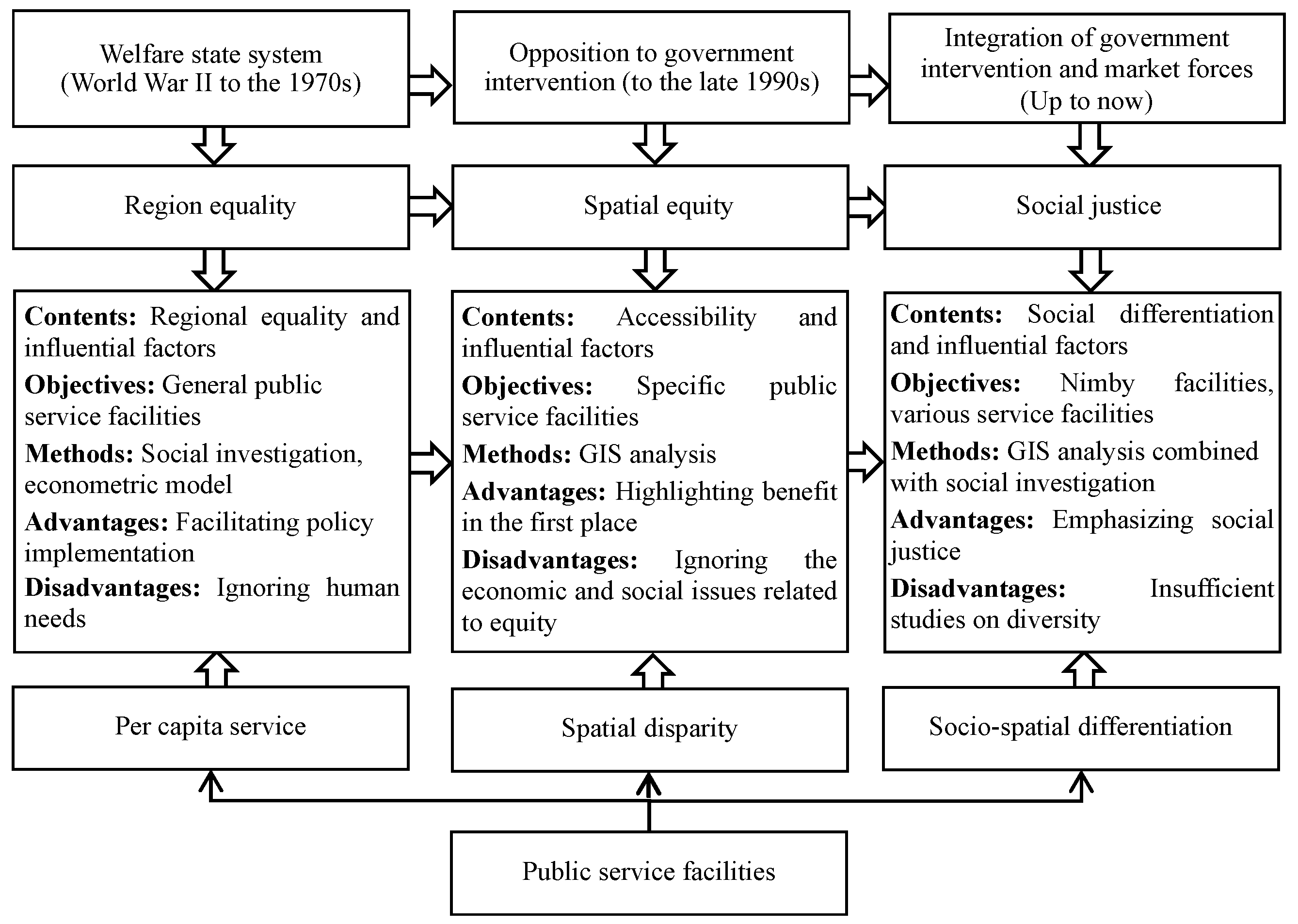

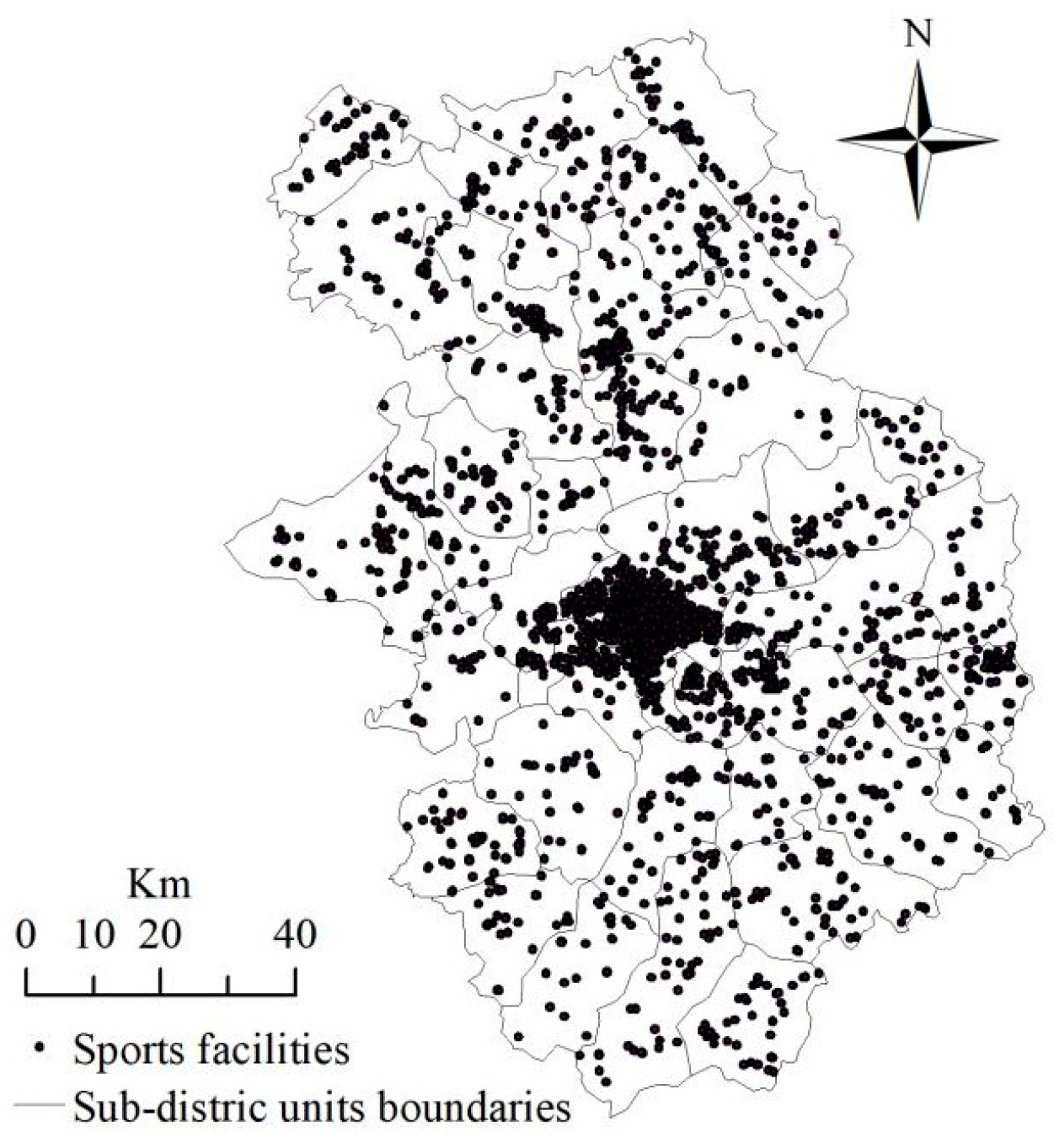
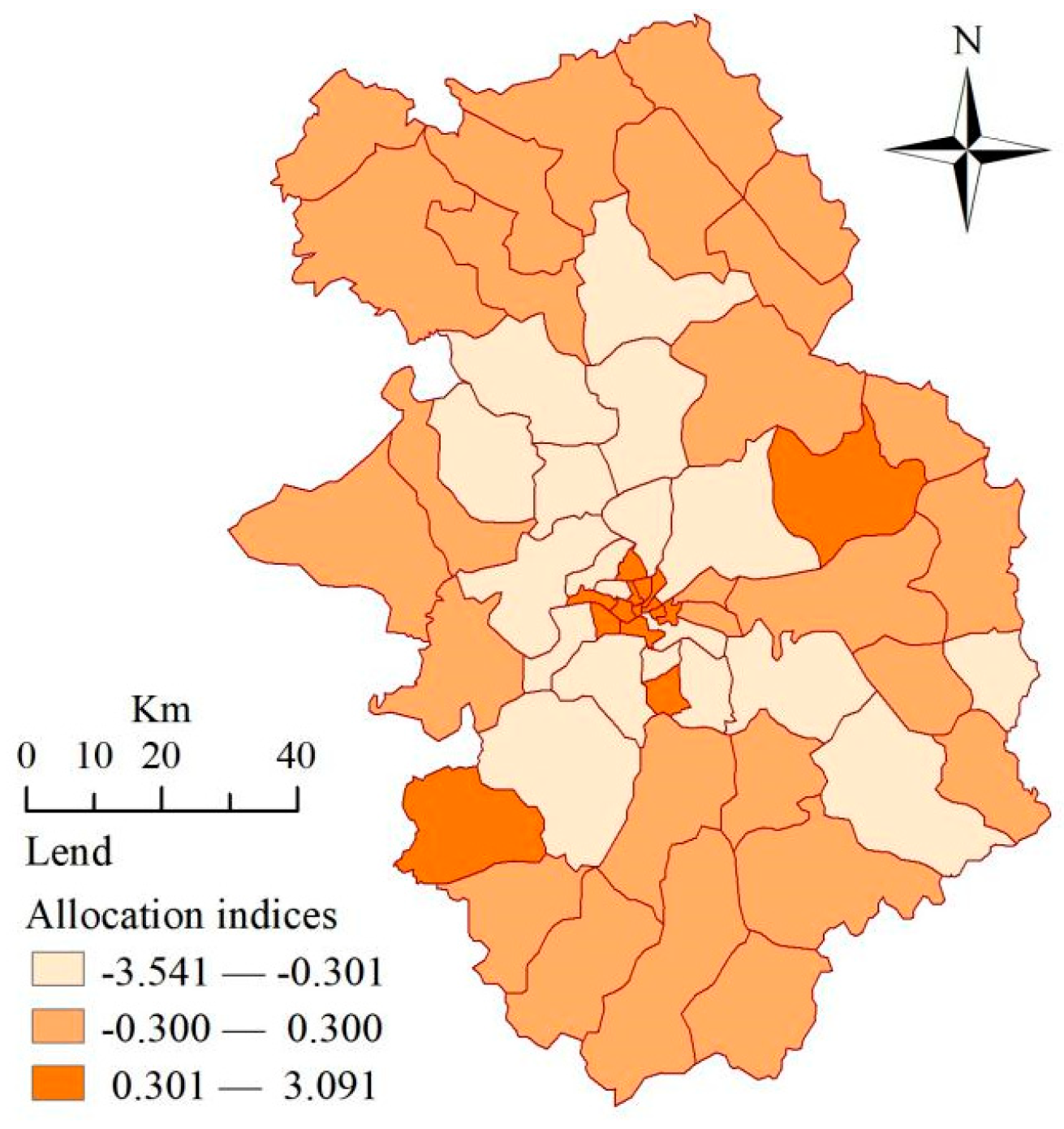
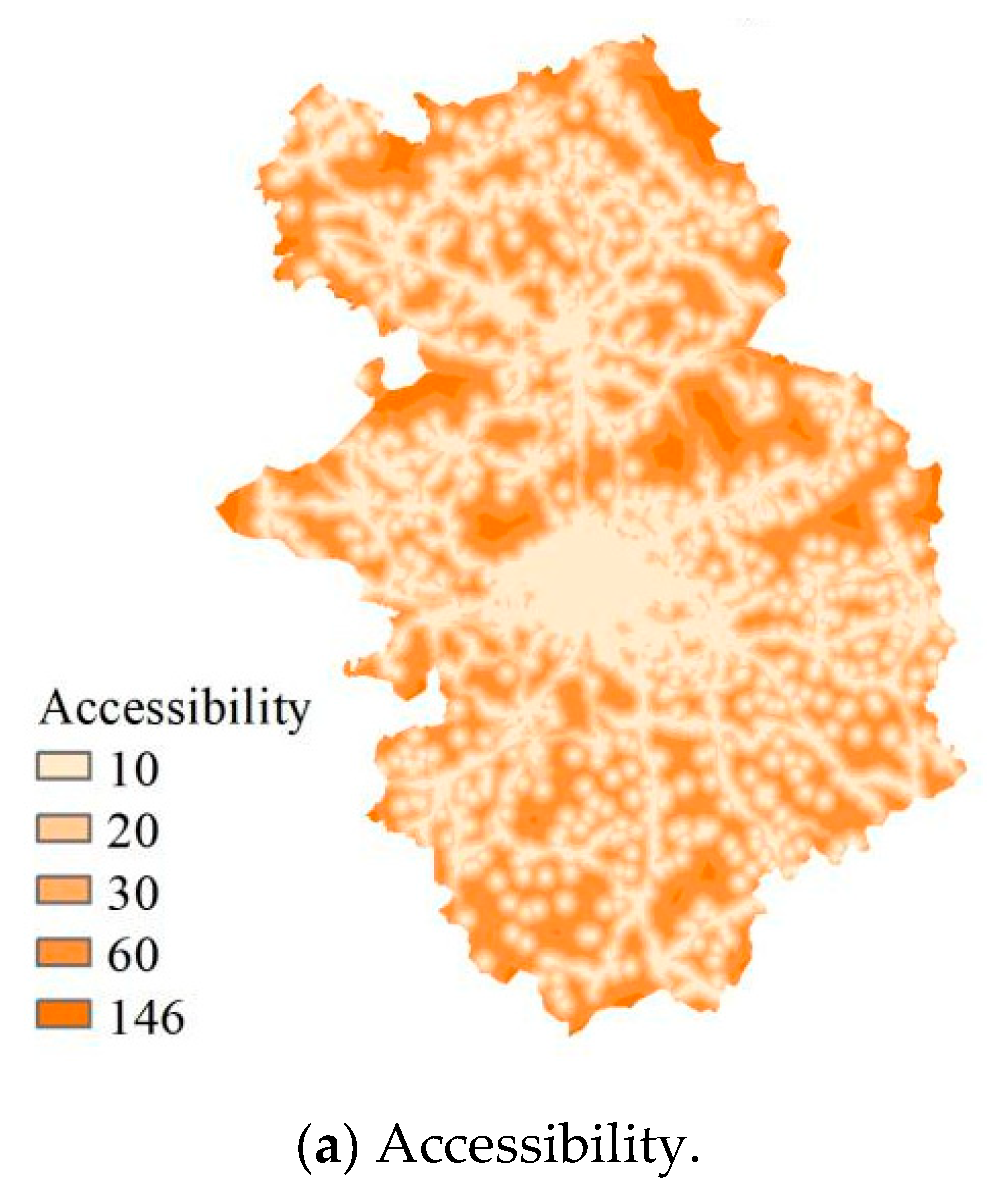
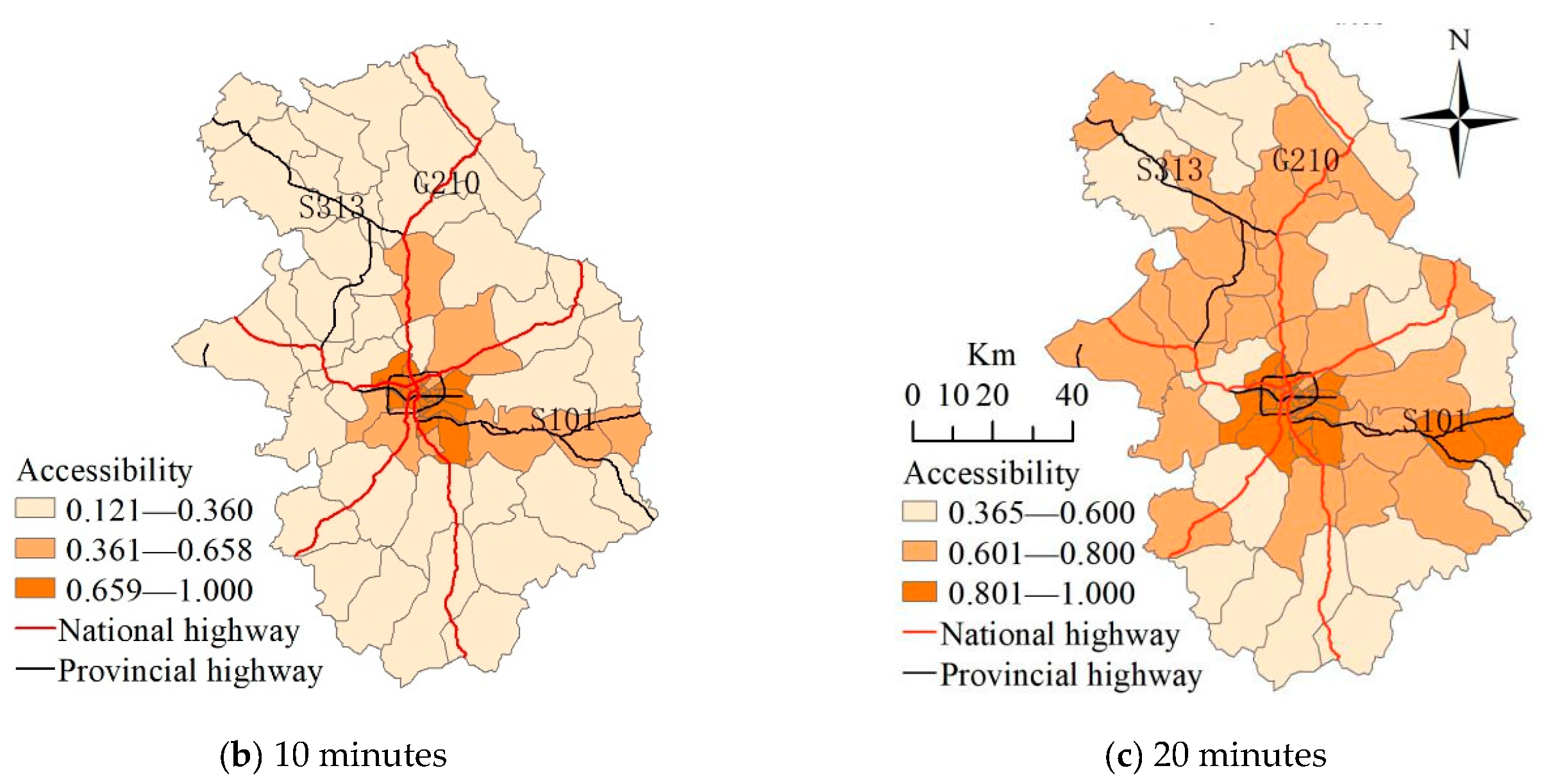
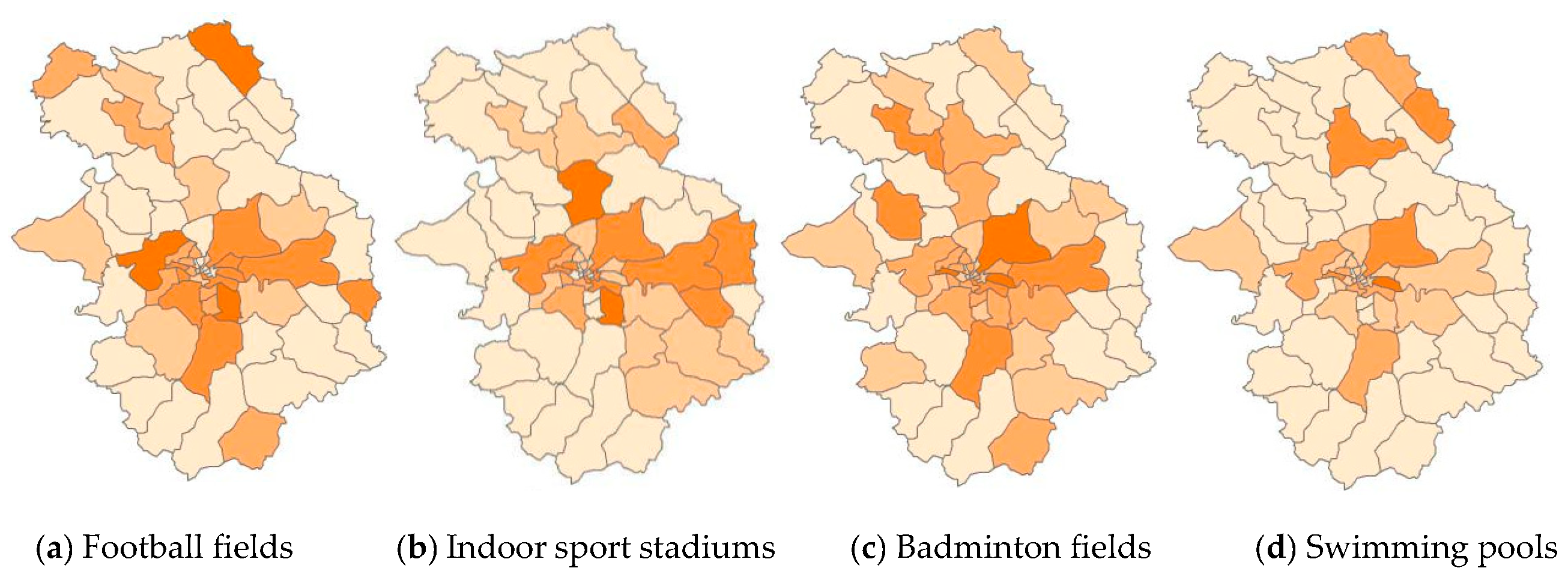

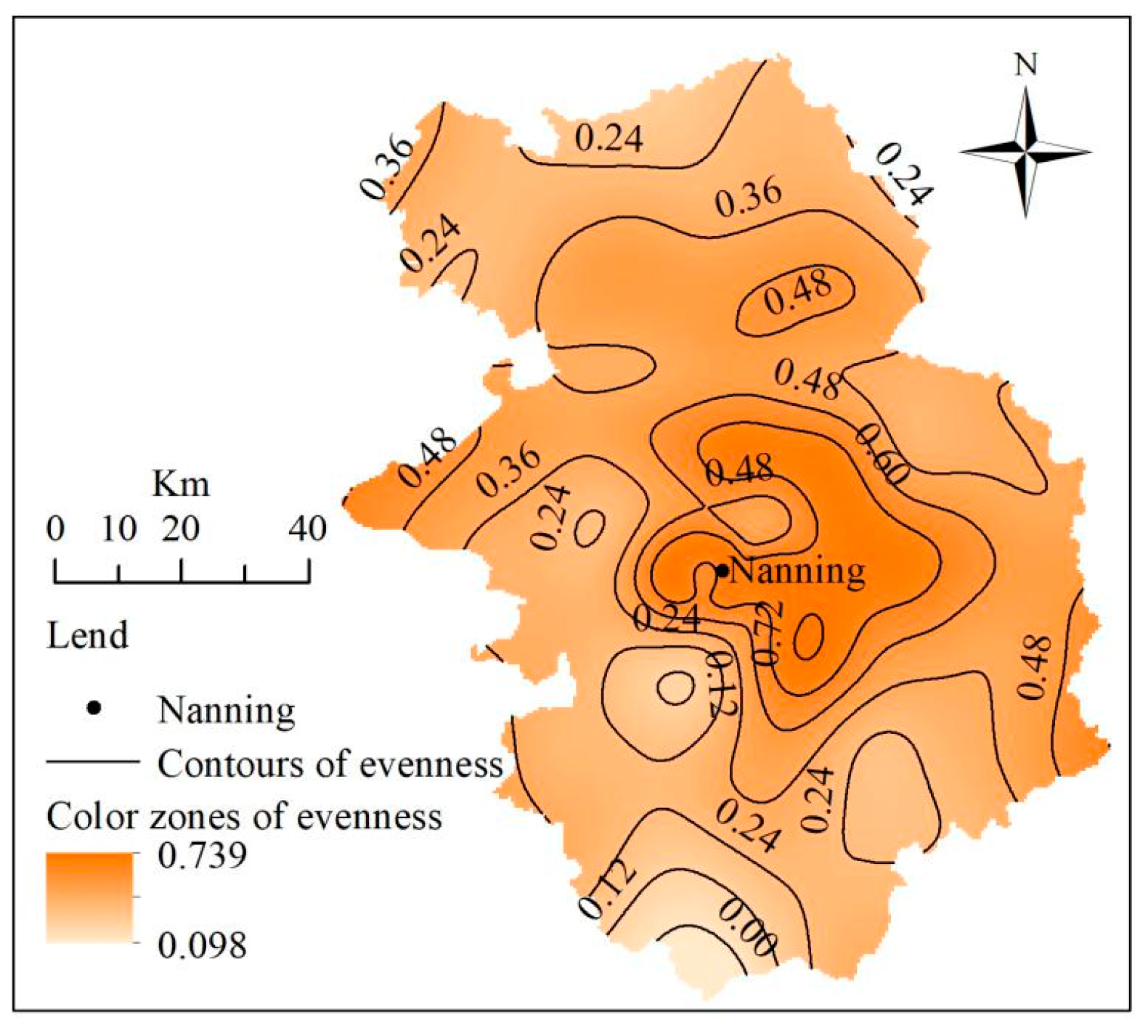

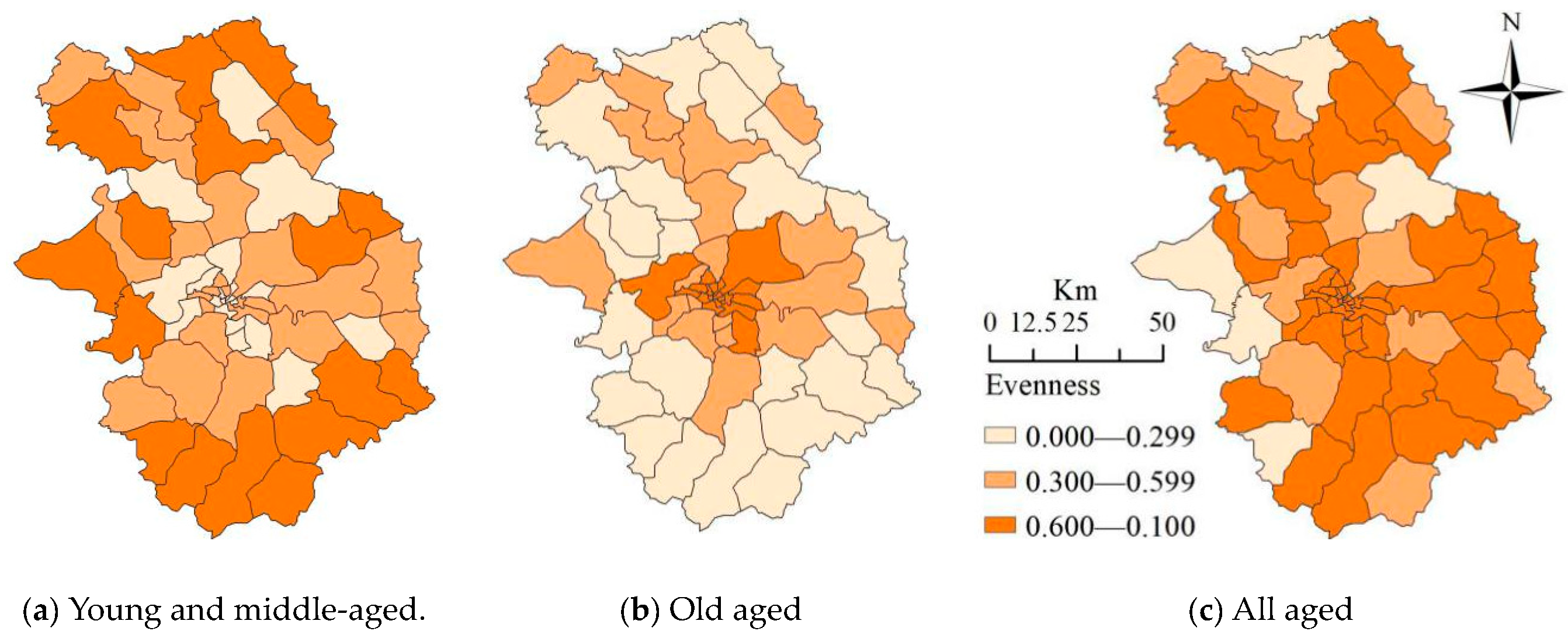
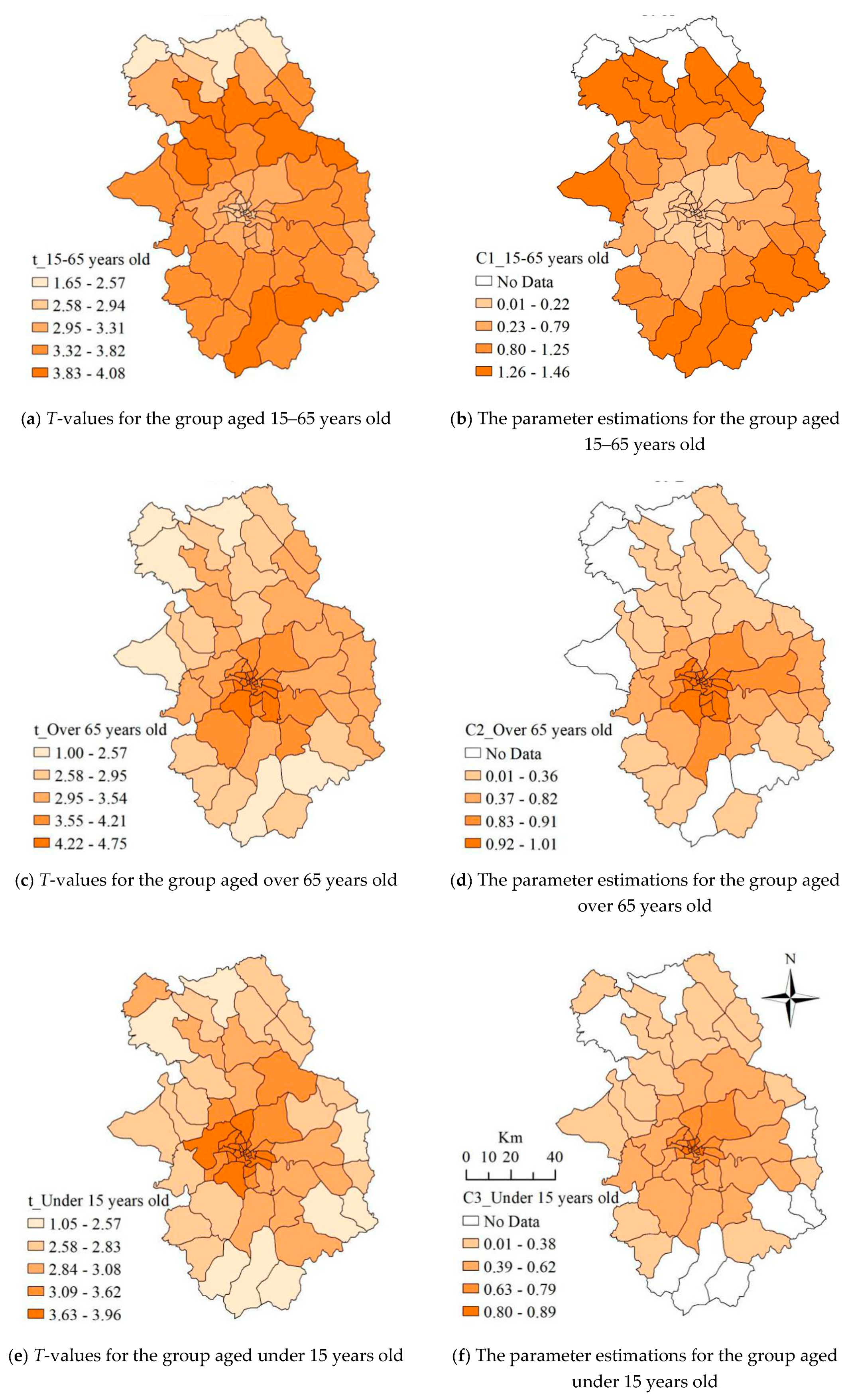
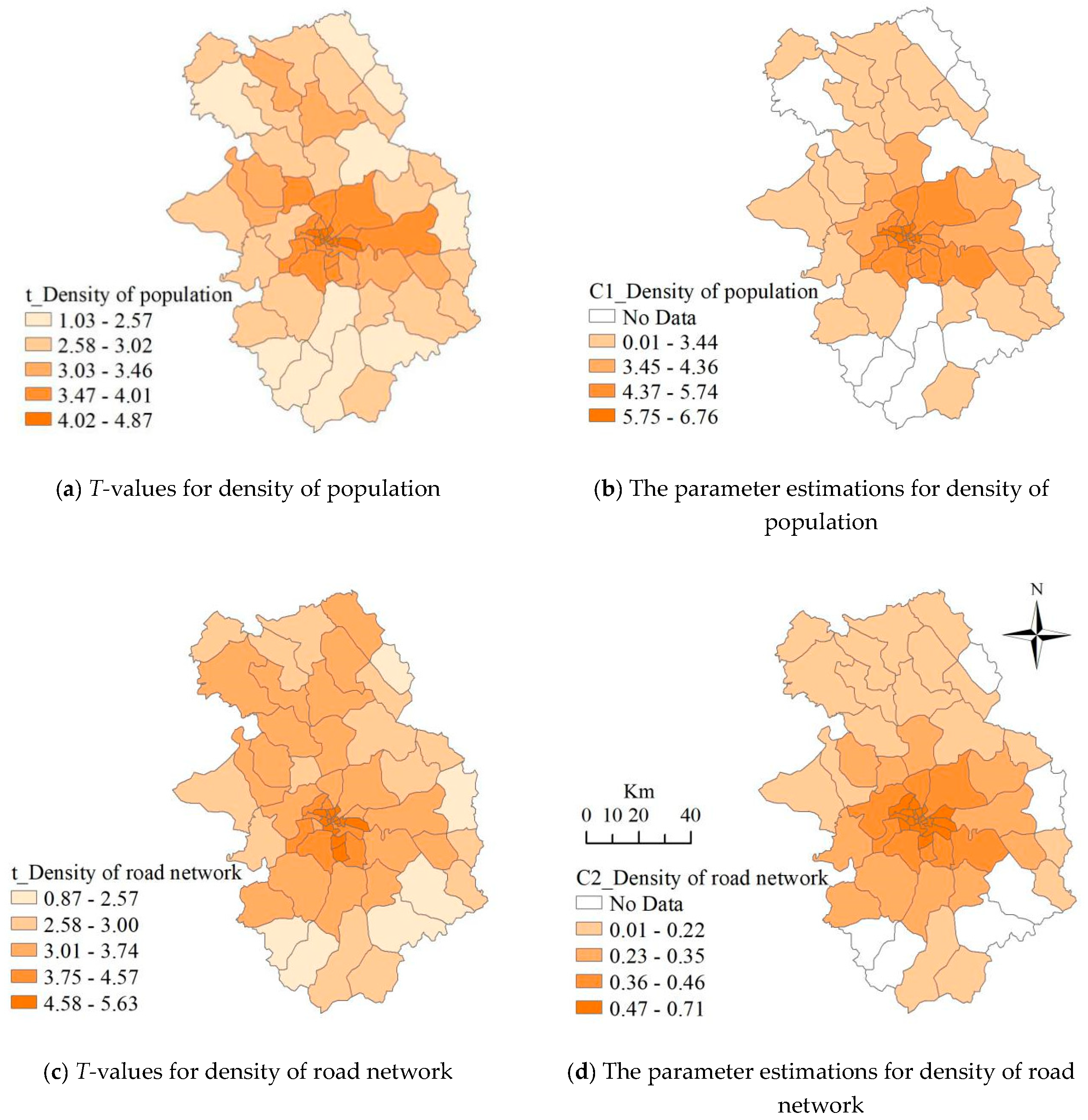
| Types | Basketball Courts | Table Tennis Courts | Athletic Tracks | Badminton Facilities | Football Fields | Air Volleyball Fields | Volleyball Courts | Outdoor Gyms | Gateball Courts | Tennis Courts | Indoor Sport Stadiums | Fitness Centers | Swimming Pools |
|---|---|---|---|---|---|---|---|---|---|---|---|---|---|
| Variation Coefficient | 0.081 | 0.115 | 0.141 | 0.144 | 0.189 | 0.210 | 0.210 | 0.219 | 0.308 | 0.312 | 0.371 | 0.377 | 0.484 |
| Explanatory Variables | Accessibility—PE Value | Accessibility—t Statistic | Investment Intensity—PE Value | Investment Intensity—t Statistic |
|---|---|---|---|---|
| <15 age group | 0.000882 | 2.963 | ||
| 15–65 age group | 0.000034 | 5.784 | ||
| >65 age group | 0.000011 | 3.016 | ||
| Population density | 0.000000 | 4.887 | ||
| Road network density | 0.000203 | 2.956 |
| Dependent Variables | Models | AICc | Adj R2 |
|---|---|---|---|
| Accessibility | OLS | −129.636 | 0.746 |
| GWR | −536.171 | 0.795 | |
| Investment intensity | OLS | −67.256 | 0.763 |
| GWR | −130.527 | 0.853 |
© 2020 by the authors. Licensee MDPI, Basel, Switzerland. This article is an open access article distributed under the terms and conditions of the Creative Commons Attribution (CC BY) license (http://creativecommons.org/licenses/by/4.0/).
Share and Cite
Shen, J.; Cheng, J.; Huang, W.; Zeng, F. An Exploration of Spatial and Social Inequalities of Urban Sports Facilities in Nanning City, China. Sustainability 2020, 12, 4353. https://doi.org/10.3390/su12114353
Shen J, Cheng J, Huang W, Zeng F. An Exploration of Spatial and Social Inequalities of Urban Sports Facilities in Nanning City, China. Sustainability. 2020; 12(11):4353. https://doi.org/10.3390/su12114353
Chicago/Turabian StyleShen, Jinghong, Jianquan Cheng, Wencong Huang, and Fantao Zeng. 2020. "An Exploration of Spatial and Social Inequalities of Urban Sports Facilities in Nanning City, China" Sustainability 12, no. 11: 4353. https://doi.org/10.3390/su12114353





